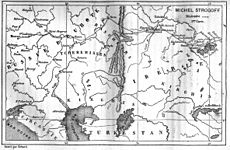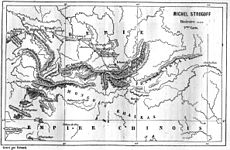
Jules Gabriel Verne was a French novelist, poet, and playwright. His collaboration with the publisher Pierre-Jules Hetzel led to the creation of the Voyages extraordinaires, a series of bestselling adventure novels including Journey to the Center of the Earth (1864), Twenty Thousand Leagues Under the Seas (1870), and Around the World in Eighty Days (1872). His novels, always well documented, are generally set in the second half of the 19th century, taking into account the technological advances of the time.

Irkutsk is the largest city and administrative center of Irkutsk Oblast, Russia. With a population of 617,473 as of the 2010 Census, Irkutsk is the 25th-largest city in Russia by population, the fifth-largest in the Siberian Federal District, and one of the largest cities in Siberia.

Marfa is a city in the high desert of the Trans-Pecos in far West Texas, United States, between the Davis Mountains and Big Bend National Park, at an elevation of 4685 feet. It is the county seat of Presidio County, and its population as of the 2020 United States Census was 1,788. The city was founded in the early 1880s as a water stop; the population peaked in the 1930s and has continued to decline each decade since. However, today Marfa is a tourist destination and a major center for minimalist art. Attractions include Building 98, the Chinati Foundation, artisan shops, historical architecture, a classic Texas town square, modern art installments, art galleries, and the Marfa lights.
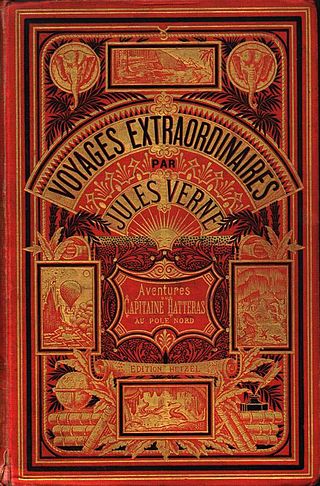
The Voyages extraordinaires is a collection or sequence of novels and short stories by the French writer Jules Verne.

Khovanshchina is an opera in five acts by Modest Mussorgsky. The work was written between 1872 and 1880 in St. Petersburg, Russia. The composer wrote the libretto based on historical sources. The opera was almost finished in piano score when the composer died in 1881, but the orchestration was almost entirely lacking.
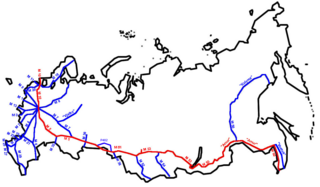
The Trans-Siberian Highway is the unofficial name for a network of federal highways that span the width of Russia from the Baltic Sea of the Atlantic Ocean to the Sea of Japan. In the Asian Highway Network, the route is known as AH6. It stretches over 11,000 kilometres from St. Petersburg to Vladivostok. The road disputes the title of the longest national highway in the world with Australia's Highway 1. The highway became fully paved on 12 August 2015.
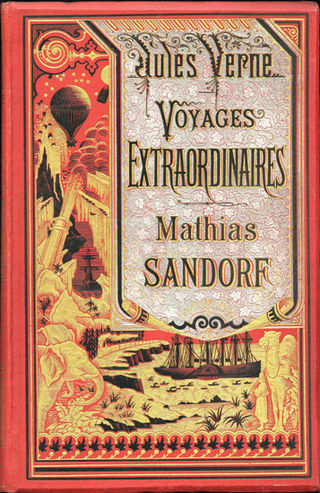
Mathias Sandorf is an 1885 adventure book by the French writer Jules Verne first serialized in Le Temps in 1885. It employs many of the devices that had served well in his earlier novels: islands, cryptograms, surprise revelations of identity, technically advanced hardware and a solitary figure bent on revenge. Verne planned Mathias Sandorf as the Mediterranean adventure of his series of novels called Voyages extraordinaires. He dedicated the novel to the memory of Alexandre Dumas.

"A Drama in Mexico" is a historical short story by Jules Verne, first published in July 1851 under the title "L'Amérique du Nord, études historiques: Les Premiers Navires de la marine mexicaine."

Jules-Descartes Férat was a French artist and illustrator, famous for his portrayals of factories and their workers.

Strogoff is a European adventure film directed in 1970 by Eriprando Visconti. It was an international co-production between Italy, West Germany and France. It is based on Jules Verne's 1876 novel Michael Strogoff reinterpreted through the lens of psychological realism.

Journey Through the Impossible is an 1882 fantasy play written by Jules Verne, with the collaboration of Adolphe d'Ennery. A stage spectacular in the féerie tradition, the play follows the adventures of a young man who, with the help of a magic potion and a varied assortment of friends and advisers, makes impossible voyages to the center of the Earth, the bottom of the sea, and a distant planet. The play is deeply influenced by Verne's own Voyages Extraordinaires series and includes characters and themes from some of his most famous novels, including Twenty Thousand Leagues Under the Sea, Journey to the Center of the Earth, and From the Earth to the Moon.

Jules Verne (1828–1905) was a French novelist, poet, and playwright. Most famous for his novel sequence, the Voyages Extraordinaires, Verne also wrote assorted short stories, plays, miscellaneous novels, essays, and poetry. His works are notable for their profound influence on science fiction and on surrealism, their innovative use of modernist literary techniques such as self-reflexivity, and their complex combination of positivist and romantic ideologies.

The Soldier and the Lady is the 1937 American adventure film version of the oft-produced 1876 Jules Verne novel, Michel Strogoff. Produced by Pandro S. Berman, he hired as his associate producer, Joseph Ermolieff. Ermolieff had produced two earlier versions of the film, Michel Strogoff in France, and The Czar's Courier in Germany, both released in 1936. Both the earlier films had starred the German actor Adolf Wohlbrück. Berman also imported Wohlbrück, changing his name to Anton Walbrook to have him star in the American version. Other stars of the film were Elizabeth Allan, Margot Grahame, Akim Tamiroff, Fay Bainter and Eric Blore. RKO Radio Pictures had purchased the rights to the French version of the movie, and used footage from that film in the American production. The film was released on April 9, 1937.

Michel Strogoff is a 1956 historical adventure film directed by Carmine Gallone and starring Curd Jürgens. It is based on 1876 novel of the same title by Jules Verne. Made as a co-production between several European nations, it was shot at the Kosutnjak Studios in Belgrade using CinemaScope.. The film's sets were designed by the art directors Léon Barsacq and Vlastimir Gavrik. Jürgens also appeared in a 1961 follow-up The Triumph of Michael Strogoff.
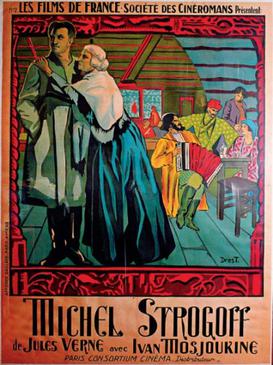
Michel Strogoff is a 1926 French silent historical adventure film directed by Viktor Tourjansky and starring Ivan Mozzhukhin, Nathalie Kovanko, and Acho Chakatouny. It is an adaptation of Jules Verne's 1876 novel Michael Strogoff. In 1961 Tourjanski directed a sequel titled Le Triomphe de Michel Strogoff.
Michel Strogoff is a 1975 French / Italian / German miniseries directed by Jean-Pierre Decourt. It is based on the novel of the same name by Jules Verne.
Michael Strogoff is a 1944 Mexican historical drama film directed by Miguel M. Delgado and starring Julián Soler, Lupita Tovar and Julio Villarreal. It is based on the 1876 Jules Verne novel Michael Strogoff.

Michel Strogoff is a 1936 French historical adventure film directed by Jacques de Baroncelli and Richard Eichberg and starring Anton Walbrook, Colette Darfeuil and Armand Bernard. It is an adaptation of the 1876 novel Michael Strogoff by Jules Verne. A separate German version The Czar's Courier was also made.

The Czar's Courier is a 1936 German historical drama film directed by Richard Eichberg and starring Anton Walbrook, Lucie Höflich, and Maria Andergast. It is an adaptation of Jules Verne's 1876 novel Michael Strogoff.

The Triumph of Michael Strogoff is a 1961 French-Italian historical adventure film directed by Viktor Tourjansky and starring Curd Jürgens, Capucine and Claude Titre. It is inspired by the 1876 novel Michael Strogoff by Jules Verne. Jürgens had previously played the role in the 1956 film Michel Strogoff.

